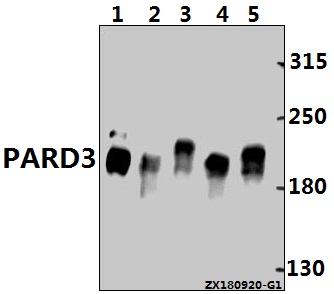Product Name :
PARD3 (F1161) polyclonal antibody Background :
Cellular asymmetry is critical for the development of multicellular organisms. PARD (partitioning-defective) proteins play important roles in asymmetric cell division and polarized growth. PARD3A (partitioning-defective 3), also known as Baz, ASIP (atypical PKC isotype-specific-interacting protein), PAR3, PARD3, PAR3α, Bazooka, SE2-5T2, SE2-5L16 or SE2-5LT1, is a 1,356 amino acid protein that contains three PDZ domains and belongs to the PAR3 family of proteins. Expressed in a wide variety of tissues, PARD3A colocalizes with PARD6A/B and PKC ι at epithelial tight junctions and is believed to function as an adapter protein with an important role in the formation of normal tight junctions at epithelial cell-cell contacts. Due to alternative splicing events, PARD3A exists in at least ten isoforms, namely isoform A, isoform B, isoform C, isoform D, isoform E, isoform F, isoform Lb, isoform Sa, isoform Sb and isoform 10. Product :
Rabbit IgG, 1mg/ml in PBS with 0.02% sodium azide, 50% glycerol, pH7.2 Storage&Stability :
Store at 4°C short term. Aliquot and store at -20°C long term. Avoid freeze-thaw cycles. Specificity :
PARD3 (F1161) polyclonal antibody detects endogenous levels of PARD3 protein. Immunogen :
Synthetic peptide, corresponding to amino acids 1131-1191 of Human PARD3. Conjugate :
Unconjugated Modification :
Unmodification
PARD3 (F1161) polyclonal antibody Background :
Cellular asymmetry is critical for the development of multicellular organisms. PARD (partitioning-defective) proteins play important roles in asymmetric cell division and polarized growth. PARD3A (partitioning-defective 3), also known as Baz, ASIP (atypical PKC isotype-specific-interacting protein), PAR3, PARD3, PAR3α, Bazooka, SE2-5T2, SE2-5L16 or SE2-5LT1, is a 1,356 amino acid protein that contains three PDZ domains and belongs to the PAR3 family of proteins. Expressed in a wide variety of tissues, PARD3A colocalizes with PARD6A/B and PKC ι at epithelial tight junctions and is believed to function as an adapter protein with an important role in the formation of normal tight junctions at epithelial cell-cell contacts. Due to alternative splicing events, PARD3A exists in at least ten isoforms, namely isoform A, isoform B, isoform C, isoform D, isoform E, isoform F, isoform Lb, isoform Sa, isoform Sb and isoform 10. Product :
Rabbit IgG, 1mg/ml in PBS with 0.02% sodium azide, 50% glycerol, pH7.2 Storage&Stability :
Store at 4°C short term. Aliquot and store at -20°C long term. Avoid freeze-thaw cycles. Specificity :
PARD3 (F1161) polyclonal antibody detects endogenous levels of PARD3 protein. Immunogen :
Synthetic peptide, corresponding to amino acids 1131-1191 of Human PARD3. Conjugate :
Unconjugated Modification :
Unmodification
-
 Western blot (WB) analysis of PARD3 (F1161) polyclonal antibody at 1:500 dilution Lane1:CT26 whole cell lysate(40ug) Lane2:PC12 whole cell lysate(40ug) Lane3:HEK293T whole cell lysate(40ug) Lane4:Hela whole cell lysate(40ug) Lane5:H1792 whole cell lysate(40ug)
Western blot (WB) analysis of PARD3 (F1161) polyclonal antibody at 1:500 dilution Lane1:CT26 whole cell lysate(40ug) Lane2:PC12 whole cell lysate(40ug) Lane3:HEK293T whole cell lysate(40ug) Lane4:Hela whole cell lysate(40ug) Lane5:H1792 whole cell lysate(40ug)
Bioworld Biotech only provide peptides for our antibodies and do not provide additional peptide customization services.
Price/Size :
USD 368/1mg/vial
Tips:
For phospho antibody, we provide phospho peptide(0.5mg) and non-phospho peptide(0.5mg).Describe :
Blocking peptides are peptides that bind specifically to the target antibody and block antibody binding. These peptide usually contains the epitope recognized by the antibody. Antibodies bound to the blocking peptide no longer bind to the epitope on the target protein. This mechanism is useful when non-specific binding is an issue, for example, in Western blotting (WB) and Immunohistochemistry (IHC). By comparing the staining from the blocked antibody versus the antibody alone, one can see which staining is specific; Specific binding will be absent from the western blot or IHC performed with the neutralized antibody.Formula:
Synthetic peptide was lyophilized with 100% acetonitrile and is supplied as a powder. Reconstitute with 0.1 ml DI water for a final concentration of 10 mg/ml.The purity is >90%,tested by HPLC and MS.
Storage:
The freeze-dried powder is more stable. For short time at 2-8°C. For long term storage store at -20°C.
Note :
This product is for research use only (RUO only). Not for use in diagnostic or therapeutic procedures.
 PARD3 (F1161) polyclonal antibody
PARD3 (F1161) polyclonal antibody  Datasheet
Datasheet COA
COA MSDS
MSDS SHIP
SHIP